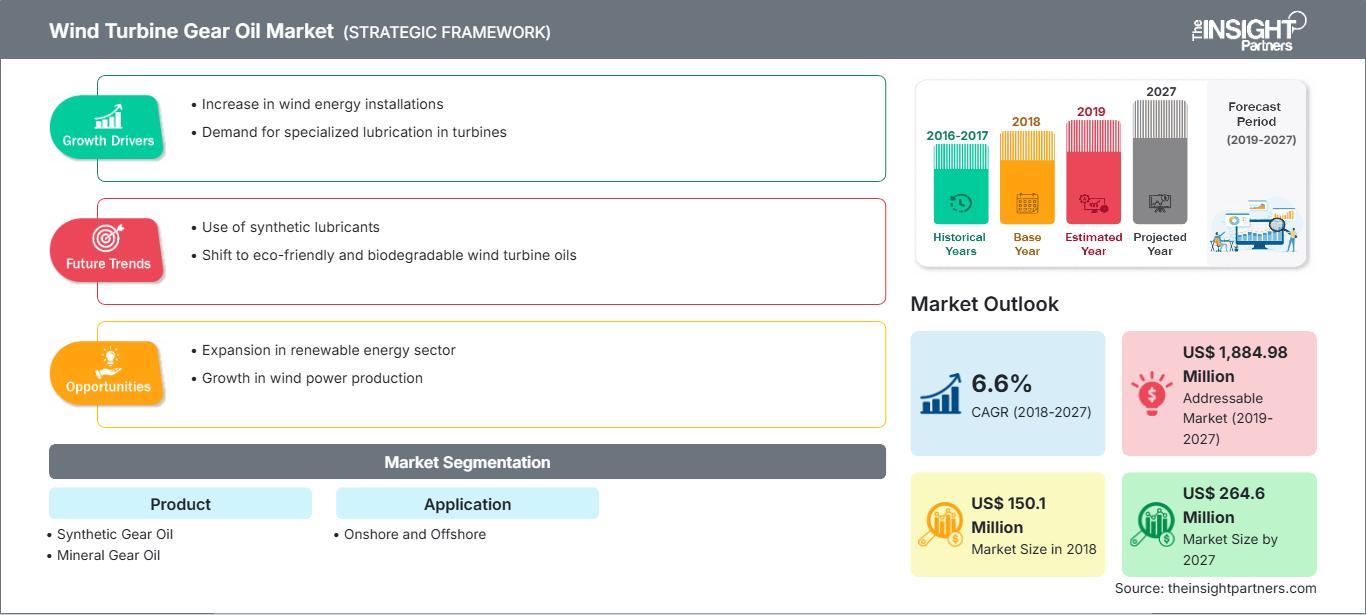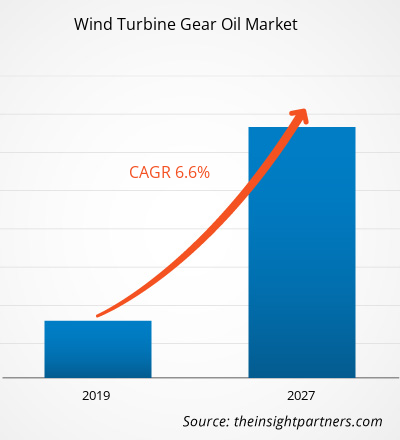Approfondimenti di mercato: il sostegno governativo al settore dell'energia eolica offre un'opportunità di crescita per il mercato degli oli per ingranaggi di turbine eoliche
Nel tentativo di affrontare il riscaldamento globale e mitigare i cambiamenti climatici, i governi di tutto il mondo stanno sostenendo la produzione e l'utilizzo dell'energia eolica. I governi e le industrie energetiche hanno effettuato investimenti su larga scala in progetti eolici per sfruttare l'energia pulita e ridurre al minimo l'impronta di carbonio. L'energia eolica sta vivendo una crescita straordinaria, poiché gli enti governativi stanno implementando politiche come sgravi fiscali, sussidiarie e prezzi minimi di acquisto per componenti e attrezzature per turbine eoliche per facilitare il passaggio dall'energia convenzionale a quella rinnovabile. Si prevede che l'aumento della spesa pubblica per lo sviluppo di impianti per la generazione di energia rinnovabile, come l'energia solare ed eolica, guiderà il mercato degli oli per ingranaggi di turbine eoliche durante il periodo di previsione.
Personalizza questo rapporto in base alle tue esigenze
Potrai personalizzare gratuitamente qualsiasi rapporto, comprese parti di questo rapporto, o analisi a livello di paese, pacchetto dati Excel, oltre a usufruire di grandi offerte e sconti per start-up e università
Mercato dell'olio per ingranaggi delle turbine eoliche: Approfondimenti strategici

-
Ottieni le principali tendenze chiave del mercato di questo rapporto.Questo campione GRATUITO includerà l'analisi dei dati, che vanno dalle tendenze di mercato alle stime e alle previsioni.
Approfondimenti sui prodotti
In base al prodotto, il mercato globale degli oli per ingranaggi per turbine eoliche è stato segmentato in olio sintetico, olio minerale e altri. A livello di segmento di prodotto, il segmento degli oli sintetici ha guidato il mercato globale degli oli per ingranaggi per turbine eoliche. L'uso di oli sintetici rispetto agli oli minerali e ad altri oli offre vantaggi grazie a minori perdite per evaporazione e tendenza alla formazione di residui, migliore lubrificazione, resistenza termica e all'ossidazione, comportamento viscosità-temperatura e proprietà a bassa temperatura; ridotta infiammabilità e resistenza agli agenti atmosferici. L'olio sintetico è un olio raffinato con dimensioni molecolari uniformi, che riduce il coefficiente di attrito e, pertanto, questo olio è sempre più utilizzato nei riduttori delle turbine per le sue eccellenti proprietà lubrificanti. Si prevede che il crescente utilizzo di olio sintetico per ingranaggi nei riduttori delle turbine per aumentarne l'efficienza guiderà le vendite di olio sintetico per ingranaggi nel periodo 2019-2027.
Approfondimenti sulle applicazioni
Il mercato globale degli oli per ingranaggi per turbine eoliche, per applicazione, è stato segmentato in onshore e offshore. Il mercato degli oli per ingranaggi per turbine eoliche per applicazioni onshore ha rappresentato la quota maggiore del mercato globale degli oli per ingranaggi per turbine eoliche. Le applicazioni onshore si riferiscono alle turbine eoliche installate sulla terraferma. Sono generalmente situate su terreni aridi su cui non vi sono restrizioni al flusso del vento. Il costo associato all'installazione di turbine eoliche onshore è relativamente inferiore rispetto a quello associato all'installazione di turbine eoliche offshore. Si prevede che il mercato degli oli per ingranaggi per turbine eoliche per il segmento onshore crescerà a un ritmo considerevole durante il periodo di previsione, a causa dell'aumento del numero di turbine eoliche di proprietà di aziende private e privati.
Fusioni e acquisizioni, lanci di prodotti e strategie di iniziative di mercato sono state adottate dai principali attori del mercato globale degli oli per ingranaggi per turbine eoliche. Di seguito sono elencati alcuni dei recenti sviluppi nel mercato globale degli oli per ingranaggi di turbine eoliche:
2019: I leader globali del settore eolico NGC, CLCP, Envision Energy e AMSOIL sono diventati ufficialmente partner strategici nel più grande mercato mondiale delle energie rinnovabili. Questo aiuta l'azienda ad ampliare la propria base clienti a livello globale. 2019: Un nuovo magazzino AS/RS, due capannoni di produzione e nuovi uffici per un totale di 16 milioni di euro vengono costruiti presso la sede di FUCHS LUBRITECH GMBH. La sede, che produce principalmente lubrificanti per applicazioni speciali, ora copre una superficie totale di 96.000 m2. 2018: AMSOIL è stata scelta da ZF Wind Power per la lubrificazione dei riduttori durante i test di fine linea in tutti i suoi stabilimenti produttivi a livello globale. L'accordo tra le due aziende consolida AMSOIL come leader globale nell'affidabilità e nelle prestazioni degli oli per ingranaggi di turbine eoliche.
Approfondimenti regionali sul mercato dell'olio per ingranaggi delle turbine eoliche
Le tendenze regionali e i fattori che influenzano il mercato dell'olio per ingranaggi di turbine eoliche durante il periodo di previsione sono stati ampiamente spiegati dagli analisti di The Insight Partners. Questa sezione illustra anche i segmenti e la geografia del mercato dell'olio per ingranaggi di turbine eoliche in Nord America, Europa, Asia-Pacifico, Medio Oriente e Africa, America meridionale e centrale.
Ambito del rapporto di mercato dell'olio per ingranaggi delle turbine eoliche
| Attributo del rapporto | Dettagli |
|---|---|
| Dimensioni del mercato in 2018 | US$ 150.1 Million |
| Dimensioni del mercato per 2027 | US$ 264.6 Million |
| CAGR globale (2018 - 2027) | 6.6% |
| Dati storici | 2016-2017 |
| Periodo di previsione | 2019-2027 |
| Segmenti coperti |
By Prodotto
|
| Regioni e paesi coperti |
Nord America
|
| Leader di mercato e profili aziendali chiave |
|
Densità degli operatori del mercato dell'olio per ingranaggi delle turbine eoliche: comprendere il suo impatto sulle dinamiche aziendali
Il mercato degli oli per ingranaggi di turbine eoliche è in rapida crescita, trainato dalla crescente domanda degli utenti finali, dovuta a fattori quali l'evoluzione delle preferenze dei consumatori, i progressi tecnologici e una maggiore consapevolezza dei vantaggi del prodotto. Con l'aumento della domanda, le aziende stanno ampliando la propria offerta, innovando per soddisfare le esigenze dei consumatori e sfruttando le tendenze emergenti, alimentando ulteriormente la crescita del mercato.

- Ottieni il Mercato dell'olio per ingranaggi delle turbine eoliche Panoramica dei principali attori chiave
- Olio sintetico per ingranaggi
- Olio minerale per ingranaggi
- Altri
Per applicazione
- Onshore
- Offshore
Per area geografica
-
Nord America
- Stati Uniti
- Canada
- Messico
-
Europa
- Germania
- Francia
- Italia
- Regno Unito
- Spagna
- Resto d'Europa
-
Asia Pacifico
- Australia
- Cina
- India
- Giappone
- Sud Corea
- Resto dell'Asia Pacifica
-
Medio Oriente e Africa
- Egitto
- Sudafrica
- Kenya
-
Sud America
- Brasile
- Argentina
- Resto del Sud America
Profili aziendali
- Amsoil Inc.
- BP plc (Castrol Limited)
- Chevron Corporation
- Exxon Mobil Corporation
- Freudenberg Group
- FUCHS Group
- HollyFrontier Corporation (Petro‐Canada Lubricants LLC)
- Royal Dutch Shell Plc.
- Schaeffer Manufacturing Co.
- TOTAL SA
- Analisi storica (2 anni), anno base, previsione (7 anni) con CAGR
- Analisi PEST e SWOT
- Valore/volume delle dimensioni del mercato - Globale, Regionale, Nazionale
- Industria e panorama competitivo
- Set di dati Excel
Report recenti
Rapporti correlati
Testimonianze
Motivo dell'acquisto
- Processo decisionale informato
- Comprensione delle dinamiche di mercato
- Analisi competitiva
- Analisi dei clienti
- Previsioni di mercato
- Mitigazione del rischio
- Pianificazione strategica
- Giustificazione degli investimenti
- Identificazione dei mercati emergenti
- Miglioramento delle strategie di marketing
- Aumento dell'efficienza operativa
- Allineamento alle tendenze normative






















 Ottieni un campione gratuito per - Mercato dell'olio per ingranaggi delle turbine eoliche
Ottieni un campione gratuito per - Mercato dell'olio per ingranaggi delle turbine eoliche